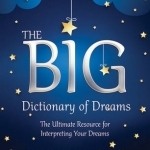Search

Catch A Dream
Book
A collection of Poems, written by Connor J Sheffield. Please feel free to use this to review any...

To Catch a Dream
Book
With good friends and a new job and, twenty-six-year-old Caitlin has it all. Strong, independent,...
Contemporary Romance Sweet Sensual

The Big Dictionary of Dreams: The Ultimate Resource for Interpreting Your Dreams
Book
Unlock the secrets hidden within your dreams with this enlightening and in-depth study. The Big...
Purple Phoenix Games (2266 KP) rated Dreams of Tomorrow in Tabletop Games
Sep 17, 2020
Let’s talk about dreams. They can range from simply reliving a stressful day at work, to remembering THAT embarrassing moment from your past, to maybe even discovering that you have superpowers. In your dreams, there are endless possibilities – but what if they meant something more? According to Dreams of Tomorrow, our dreams actually serve a bigger purpose!
Dreams of Tomorrow is game of set collection that utilizes a shifting rondel (I had to look up the definition too) in which players are working to weave a series of dreams into a complete Dream Sequence. Set in the future, players take on the roles of Dream Engineers, who are tasked with creating Dream Sequences to be sent to the past in an effort to save the future. Can you weave the most powerful Dream Sequence to alter the path of your present life, or is the future doomed to fall?
DISCLAIMER: We were provided a copy of this game for the purposes of this review. This is a retail copy of the game, so what you see in these photos is exactly what would be received in your box. I do not intend to cover every single rule included in the rulebook, but will describe the overall game flow and major rule set so that our readers may get a sense of how the game plays. For more in depth rules, you may purchase a copy online or from your FLGS. -L
To setup the game, place the Collective Consciousness (the rondel) in numerical order within reach of all players. Reveal a number of Dream cards from the Dream deck, based on the number of players, and these cards will create the communal Dreamscape. Each player receives a player card, cubes, and meeple in their chosen color, and sets their resources to the starting numbers, as described in the rulebook. All players begin with their meeples in the first space of the rondel, and in clockwise order, will select and pay for a Dream from the Dreamscape to be placed in their Dream Catcher (waiting area). Once all players have selected a Dream, and adjusted their resources accordingly, the game is ready to begin.
Dreams of Tomorrow is played over a series of rounds in which players will take turns performing 2 actions: Move and Take Action. Movement happens sequentially around the rondel, and players may choose how many spaces to move. To move 1-3 spaces is free, but to move more than 3 spaces will cost a number of resources. When a player decides to end their movement, they will then take the action indicated on the space on which they landed. These actions include: Gaining resources, Catching a Dream, Weaving a Dream, or Activating a Dream Ability. Gaining resources is pretty self-explanatory, and there is one neat thing to note: even if it is not your active turn, most of the rondel spaces have a Shared Effect, which grants an off-turn action to all non-active players. Catching a Dream means that you pay the requisite resources and select a Dream from the Dreamscape. Any caught Dreams go into your Dream Catcher until you are able to perform the Weave a Dream action. When you Weave a Dream, you again pay the requisite resources displayed on the Dream card and move the Dream from your Dream Catcher into your Dream Sequence (play area). To Activate a Dream Ability, you select a Dream card in your tableau, and use the ability printed on it. It is important to note that once Dreams are woven into your Dream Sequence, they will overlap each other, and only one Dream Ability will ever be available for use, so create that sequence wisely! Play continues in turns until one player has woven a Dream Sequence of five Dreams total. The round ends once all players have taken the same number of turns, and then final points are counted. The player with the highest score is the winner!
So all-in-all, how is Dreams of Tomorrow as a whole? I actually was very surprised at how much I enjoyed this game. When reading through the rules, it seemed kind of complicated and I was a bit worried before my first play. Once you actually get playing, however, the game is pretty intuitive and simple to play. One thing I particularly enjoyed about this game is its iconography. With only three resources and four actions, there are only seven icons of which to keep track. It keeps the cards from being cluttered with text, and makes the costs/abilities clear to understand. The iconography of the Dream Abilities, however, can be a liiiittle more complicated, but the game does come with Reference Cards which explain what every single icon means!
Another neat thing I enjoyed about this gameplay is the addition of Shared Effects. Even if you are not the active player, you will always gain some resource on everyone else’s turn. That adds an extra element of strategy because you have to amass your own resources for Dreams, but you have to be careful not to be giving your opponents too much extra help for themselves! Probably my favorite part of Dreams of Tomorrow are the actual Dream Abilities themselves. Performing the regular turn actions are pretty straight-forward, but Dream Abilities are more special and allow you to do even more on your turn. For example, some Dream Abilities allow you to change directions, move extra spaces, or even alter the Collective Consciousness, re-arranging the cards in a way to benefit you and hopefully hinder your opponents. The Dream Abilities are literal game-changers, and they really keep all players on their toes.
Talking about components, this game is of a pretty good quality. The cards are nice and sturdy, the player boards are decent, and the meeples and cubes are your standard wooden tokens. I’ve said in reviews before, but I always appreciate when games include Reference Cards for players, and Dreams of Tomorrow certainly delivered on theirs. The cards are clear, concise, and helpful during play. The artwork of this game is very vibrantly colorful and just plain pretty to look at. I found myself getting distracted by admiring the artwork, or catching Dreams based on their artwork, instead of taking their point-values or resources requirements into consideration. Oops. That’s just my bad, but the artwork really helps make the game more immersive.
Overall, I would say that Dreams of Tomorrow is a great little game. Admittedly, the rulebook is kind of daunting and seems a little overly complicated at first, but once you get into an actual game, it flows very quickly and easily. After just one turn, I got exactly what was happening and had no further questions about the gameplay. It really went above and beyond my expectations, and is one that I definitely look forward to bringing out in future game nights. Purple Phoenix Games gives it a dreamy 10 / 12. Check this one out if you haven’t before, it may just be the game of your dreams. (Ha, get it?)
Dreams of Tomorrow is game of set collection that utilizes a shifting rondel (I had to look up the definition too) in which players are working to weave a series of dreams into a complete Dream Sequence. Set in the future, players take on the roles of Dream Engineers, who are tasked with creating Dream Sequences to be sent to the past in an effort to save the future. Can you weave the most powerful Dream Sequence to alter the path of your present life, or is the future doomed to fall?
DISCLAIMER: We were provided a copy of this game for the purposes of this review. This is a retail copy of the game, so what you see in these photos is exactly what would be received in your box. I do not intend to cover every single rule included in the rulebook, but will describe the overall game flow and major rule set so that our readers may get a sense of how the game plays. For more in depth rules, you may purchase a copy online or from your FLGS. -L
To setup the game, place the Collective Consciousness (the rondel) in numerical order within reach of all players. Reveal a number of Dream cards from the Dream deck, based on the number of players, and these cards will create the communal Dreamscape. Each player receives a player card, cubes, and meeple in their chosen color, and sets their resources to the starting numbers, as described in the rulebook. All players begin with their meeples in the first space of the rondel, and in clockwise order, will select and pay for a Dream from the Dreamscape to be placed in their Dream Catcher (waiting area). Once all players have selected a Dream, and adjusted their resources accordingly, the game is ready to begin.
Dreams of Tomorrow is played over a series of rounds in which players will take turns performing 2 actions: Move and Take Action. Movement happens sequentially around the rondel, and players may choose how many spaces to move. To move 1-3 spaces is free, but to move more than 3 spaces will cost a number of resources. When a player decides to end their movement, they will then take the action indicated on the space on which they landed. These actions include: Gaining resources, Catching a Dream, Weaving a Dream, or Activating a Dream Ability. Gaining resources is pretty self-explanatory, and there is one neat thing to note: even if it is not your active turn, most of the rondel spaces have a Shared Effect, which grants an off-turn action to all non-active players. Catching a Dream means that you pay the requisite resources and select a Dream from the Dreamscape. Any caught Dreams go into your Dream Catcher until you are able to perform the Weave a Dream action. When you Weave a Dream, you again pay the requisite resources displayed on the Dream card and move the Dream from your Dream Catcher into your Dream Sequence (play area). To Activate a Dream Ability, you select a Dream card in your tableau, and use the ability printed on it. It is important to note that once Dreams are woven into your Dream Sequence, they will overlap each other, and only one Dream Ability will ever be available for use, so create that sequence wisely! Play continues in turns until one player has woven a Dream Sequence of five Dreams total. The round ends once all players have taken the same number of turns, and then final points are counted. The player with the highest score is the winner!
So all-in-all, how is Dreams of Tomorrow as a whole? I actually was very surprised at how much I enjoyed this game. When reading through the rules, it seemed kind of complicated and I was a bit worried before my first play. Once you actually get playing, however, the game is pretty intuitive and simple to play. One thing I particularly enjoyed about this game is its iconography. With only three resources and four actions, there are only seven icons of which to keep track. It keeps the cards from being cluttered with text, and makes the costs/abilities clear to understand. The iconography of the Dream Abilities, however, can be a liiiittle more complicated, but the game does come with Reference Cards which explain what every single icon means!
Another neat thing I enjoyed about this gameplay is the addition of Shared Effects. Even if you are not the active player, you will always gain some resource on everyone else’s turn. That adds an extra element of strategy because you have to amass your own resources for Dreams, but you have to be careful not to be giving your opponents too much extra help for themselves! Probably my favorite part of Dreams of Tomorrow are the actual Dream Abilities themselves. Performing the regular turn actions are pretty straight-forward, but Dream Abilities are more special and allow you to do even more on your turn. For example, some Dream Abilities allow you to change directions, move extra spaces, or even alter the Collective Consciousness, re-arranging the cards in a way to benefit you and hopefully hinder your opponents. The Dream Abilities are literal game-changers, and they really keep all players on their toes.
Talking about components, this game is of a pretty good quality. The cards are nice and sturdy, the player boards are decent, and the meeples and cubes are your standard wooden tokens. I’ve said in reviews before, but I always appreciate when games include Reference Cards for players, and Dreams of Tomorrow certainly delivered on theirs. The cards are clear, concise, and helpful during play. The artwork of this game is very vibrantly colorful and just plain pretty to look at. I found myself getting distracted by admiring the artwork, or catching Dreams based on their artwork, instead of taking their point-values or resources requirements into consideration. Oops. That’s just my bad, but the artwork really helps make the game more immersive.
Overall, I would say that Dreams of Tomorrow is a great little game. Admittedly, the rulebook is kind of daunting and seems a little overly complicated at first, but once you get into an actual game, it flows very quickly and easily. After just one turn, I got exactly what was happening and had no further questions about the gameplay. It really went above and beyond my expectations, and is one that I definitely look forward to bringing out in future game nights. Purple Phoenix Games gives it a dreamy 10 / 12. Check this one out if you haven’t before, it may just be the game of your dreams. (Ha, get it?)

Let Your Kids Go Wild Outside: Creative Ways to Help Children Discover Nature and Enjoy the Great Outdoors
Book
Creative ways for children to spend time outdoors and discover nature. In an era when the iPad is...
